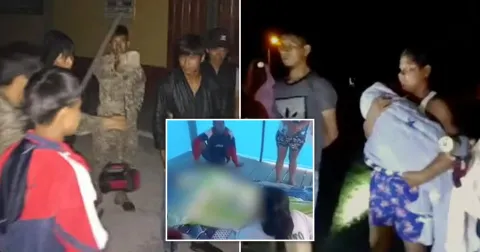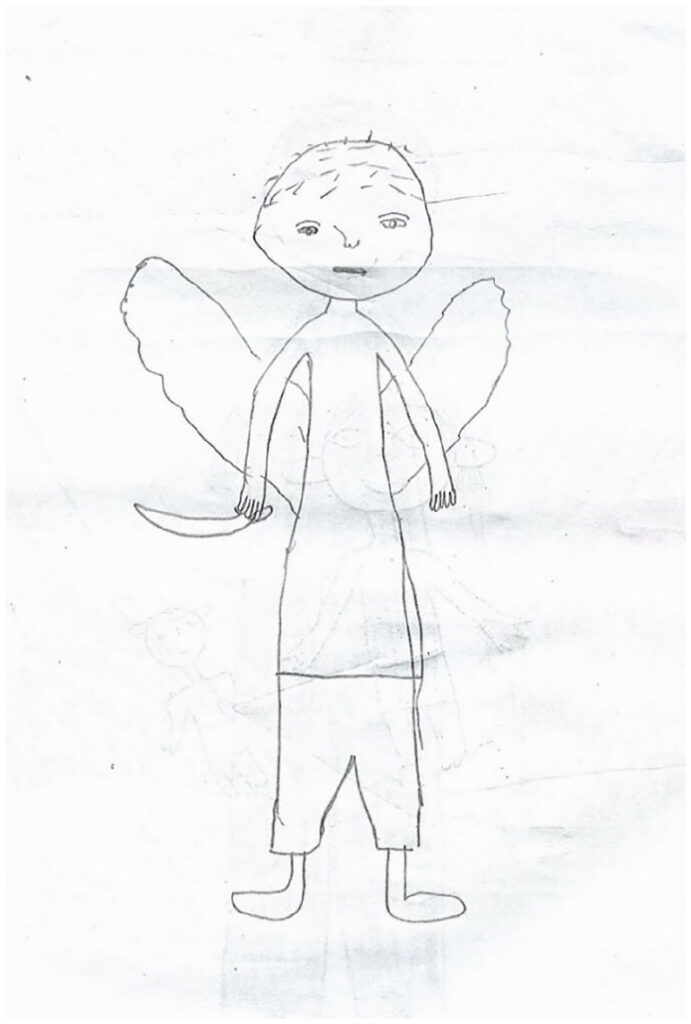by Charles Lear, author of “The Flying Saucer Investigators.”
 This is the last in a three-part series of blogs looking at a case from 2023 that involved Ikitu tribe members in the village of San Antonio de Pintuyacu in Peru who reported nighttime attacks by 7-feet-tall aliens with elongated heads wearing black body armor and masks that had yellow or green eye lenses. They were said to stand on some sort of circular device like Green Goblin from the Spiderman movie that enabled them to fly and hover. Some villagers attributed the attacks to creatures from local folklore called Los Pelacaras (The Face-Peelers) said to feed on human faces and organs. Adding credence to this belief, a 15-year-old girl, identified as Talia, suffered an attack that resulted in her being taken to a hospital with lacerations on her neck. Witnesses reported that, as they came to her rescue, they saw the attackers flying away. Police came to investigate, and a spokesman for the Peruvian National Prosecutor’s office, Carlos Castro Quintanilla, came to the conclusion that illegal gold miners using jetpacks to explore deep into the jungle were responsible. This caused the story to die down in the news, but Timothy Alberino, a documentary film maker and paranormal enthusiast based in Bozeman, Montana, who had spent a good deal of time as a young man living in the jungles of Peru, returned to investigate the story first-hand and shared his findings on his YouTube site and on podcasts. While the descriptions of the creatures and the encounters were quite strange, there is a history of these sorts of reports linked to outsiders seeking to exploit natural resources in areas occupied by indigenous people, often with little concern for their rights.
This is the last in a three-part series of blogs looking at a case from 2023 that involved Ikitu tribe members in the village of San Antonio de Pintuyacu in Peru who reported nighttime attacks by 7-feet-tall aliens with elongated heads wearing black body armor and masks that had yellow or green eye lenses. They were said to stand on some sort of circular device like Green Goblin from the Spiderman movie that enabled them to fly and hover. Some villagers attributed the attacks to creatures from local folklore called Los Pelacaras (The Face-Peelers) said to feed on human faces and organs. Adding credence to this belief, a 15-year-old girl, identified as Talia, suffered an attack that resulted in her being taken to a hospital with lacerations on her neck. Witnesses reported that, as they came to her rescue, they saw the attackers flying away. Police came to investigate, and a spokesman for the Peruvian National Prosecutor’s office, Carlos Castro Quintanilla, came to the conclusion that illegal gold miners using jetpacks to explore deep into the jungle were responsible. This caused the story to die down in the news, but Timothy Alberino, a documentary film maker and paranormal enthusiast based in Bozeman, Montana, who had spent a good deal of time as a young man living in the jungles of Peru, returned to investigate the story first-hand and shared his findings on his YouTube site and on podcasts. While the descriptions of the creatures and the encounters were quite strange, there is a history of these sorts of reports linked to outsiders seeking to exploit natural resources in areas occupied by indigenous people, often with little concern for their rights.
Stories like the ones that came out of San Antonio have come from indigenous people living in the Amazon River region since the 1500s, and an article published in 2011 in Vol. 16, No. 1 pp 143-167 of The Journal of Latin American and Caribbean Anthropology looks at the history of such stories and the cultural pressures that gave rise to them. The article is titled “Bundles, Stampers, and Flying Gringos: Native Perceptions of Capitalist Violence in Peruvian Amazonia” and was written by Fernando Santos Granero and Frederica Barclay. The Abstract is as follows:
This article examines a set of stories told among the Awajun, Wampis, and Ashaninka of eastern Peru, which feature a diversity of white supernatural beings that wander about their communities to steal their vital force, or introduce harmful substances into their bodies. These stories constitute a response to the capitalist violence experienced at present by these peoples as a result of hardline government policies promoting private investment, and the frenzied activities of extractive corporations eager to profit from the region’s natural resources. Such stories are informed by indigenous notions about personhood and illness, but also by native eco-cosmologies that view life as a scarce resource – the object of intense interspecific competition. What distinguishes this from past junctures of predation by white people is that on this occasion native Amazonians feel that the government and its allies have set out to exterminate them once and for all.
The article begins with a description of the June 5, 2000 “Bagua Massacre” after the Peruvian government ordered the removal of Awajun and Wampis protesters who were blocking a road near the town of Bagua. The ensuing confrontation resulted in the deaths of 33 people, including 9 policemen out of 38 who were taken as hostages. The episode is described as “a critical point in the struggle of native Amazonian peoples against multiple aggressions by the government of President Alan García (2006–11).”
The authors argue that the fears of Awajun, Wampis, and Ashaninka “are expressed in the appearance of a number of stories about the activities of several supernatural beings with white physiognomies, who wander about native communities equipped with strange contraptions that make them invulnerable and allow them to spy on and attack (more or less covertly) its members.”
The authors put the stories in the context of the cosmology shared by the three groups. According to them, the people in the region believe that all living creatures began as human and lived in harmony until, due to the fallibility of the creator gods or the humans, some humans were transformed into the various living extant forms and that all have retained a human-shaped soul. Along with this, they believe that the life force is scarce and that all living things live in fierce competition to acquire it. All things being human in origin, hunters show a respect for their prey that “results in an ethic of self-regulation that ensures a balance among the species despite the practice of generalized predation.” According to the authors, the stories about supernatural white beings that mark bodies (stampers), introduce foreign substances, and extract “vital substances” from their victims, stem from this belief system.
The authors bring up stories about “pishtacos” (throat cutters) and “pelecaras” that circulated in the 1980s during a period of “aggressive colonization, deforestation, and road-building projects promoted by Presidents Fernando Belaunde (1980–85) and Alan García (1985–90). According to the authors, pishtaco stories were chronicled as far back as 1571 by Cristóbal de Molina.
Under the heading “Indigenous Perceptions of Capitalist Violence,” some of the stories of seemingly supernatural beings coming into villages to commit acts of violence are examined. They present this email “sent on January 6, 2009, by Edinson Espíritu, an Ashaninka from the Perene River to the members of the AMA Bilingual Intercultural Network, a non-profit organization devoted to improving the quality of life of Andean–Amazonian communities:”
 Dear friends, brothers, colleagues, comrades, allies and public in general. Yesterday, an Ashaninka sister declared to us that in the Ashaninka territory–selva central, people (gringos) have appeared dressed in trousers, shirts, shoes, helmets and iron wings; the wings help them travel from one place to another; we believe they operate with some sort of fuel; no bullets can enter their clothing; they kill boys and girls without pity to extract only their eyes and hearts; up until now there have already disappeared several Ashaninka boys and girls; for this reason we alert all men and women who are not yet aware of this to remain vigilant. People, in particular Ashaninka who live in dispersed areas distant from towns, please organize and you know what to do.
Dear friends, brothers, colleagues, comrades, allies and public in general. Yesterday, an Ashaninka sister declared to us that in the Ashaninka territory–selva central, people (gringos) have appeared dressed in trousers, shirts, shoes, helmets and iron wings; the wings help them travel from one place to another; we believe they operate with some sort of fuel; no bullets can enter their clothing; they kill boys and girls without pity to extract only their eyes and hearts; up until now there have already disappeared several Ashaninka boys and girls; for this reason we alert all men and women who are not yet aware of this to remain vigilant. People, in particular Ashaninka who live in dispersed areas distant from towns, please organize and you know what to do.
The authors present a report from the January 31, 2009, La Voz Municipal, a monthly bulletin in Awajun–Wampis territory:
… we were informed of spine-chilling events such as the presence of gringos that appeared; seven community members told us how these beings were; they said that a being descended from space inside a glass sphere and that it reflected multicolored lights; they had made several shots from a distance of 3 meters, but the pellets would not penetrate the bundle; we stayed one night to capture the image of the supposed gringo; we wandered about almost all night long but with no results. We urge people to remain alert in the face of this situation and inform local authorities immediately. Whether this be true or not, we must remain alert. (Boletín 2009)
These stories are obviously quite similar to the stories that came out of San Antonio in 2023, and whatever their true source, illegal gold miners with jetpacks seems a most unlikely explanation given the long history of these sorts of reports. At least, in the case of the 2023 reports, the Peruvian government was on the side of the San Antonio villagers.
Podcast: Play in new window | Download